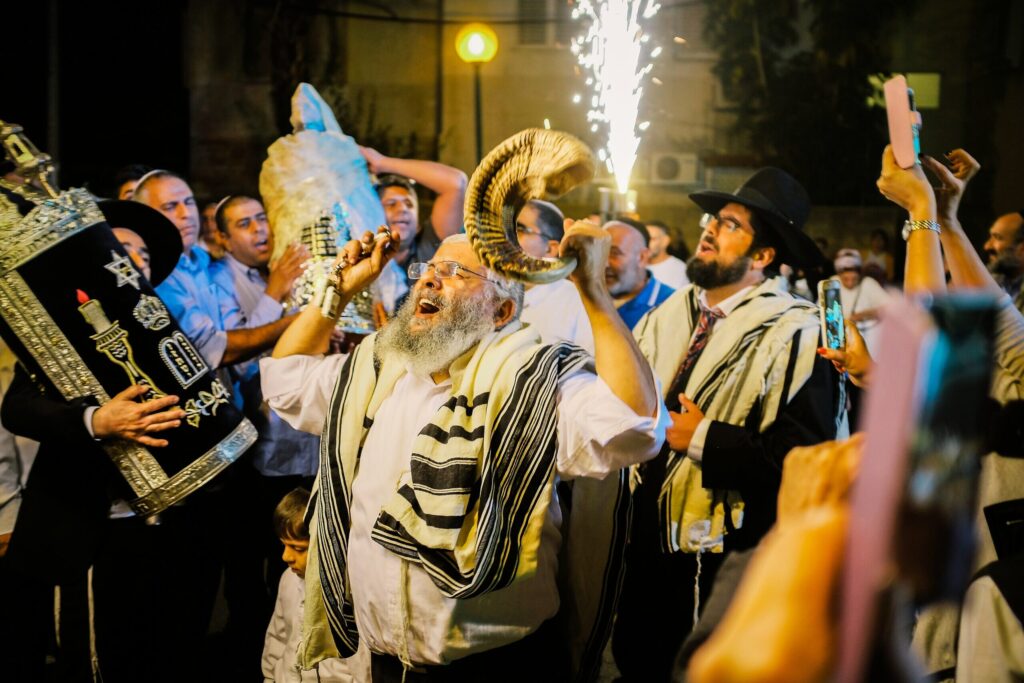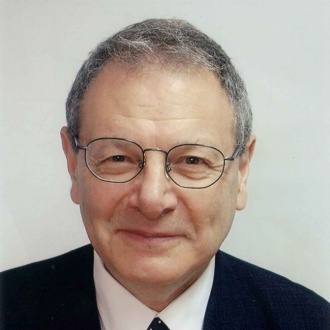The Thrill of Intimacy
The radical transition from the Yom Kippur solemnity to the Simchat Torah revelry can be dizzying, but it makes sense. There is a method to the madness.
The Chupah
Yom Kippur is like a wedding between G-d and the Jewish people. This is why we fast on this day. Just as we fast on the day of our wedding, so do we fast on Yom Kippur.
Jewish weddings begin with a somber chupah ceremony, where the bride and groom are joined. On Yom Kippur, when the high priest would enter the Holy of Holies in the temple of old and spread incense over a pan of coals, a cloud of steam would envelop the room. The high priest represented the Jews, and the Holy of Holies represented G-d. They stood together under this cloud, which represented their chupah.
It was a somber moment, but also a thrilling one. G-d and Jew were betrothed, activating their inherent oneness. G-d’s unconditional love for His bride was revealed as He forgave their sins, wiped their slate, and gathered them in.
The Yichud Room
After the chupah, the bride and groom are escorted to a yichud room where they spend a few moments in private. Away from joyful guests and prying eyes, they experience their first alone moments as a couple. In our relationship with G-d, this occurs during the final hour of Yom Kippur, when we pray Neilah. At this time, G-d directs the angels to leave His chambers and locks the gates so that the Jew and G-d are entirely alone. These are the most intense moments of Yom Kippur, ending on a spiritual high. G-d and the Jews are united. Connected as one, they emerge into the year, and the merrymaking begins.
The Anticipation Builds
The next four days are a whirlwind of preparation as we build the sukkah and procure the four species to be waved during Sukkot. This is akin to those exciting moments, when the bride and groom emerge from their cocoon, their alone time, and prepare to enter the ballroom where the guests are congregated. The music swirls, the anticipation rises, the excitement reaches a fever pitch until the doors are thrown wide and the celebrated couple enters. The guests erupt in dance and song, twirling around the dance floor.
Those moments of anticipation between the yichud room and the entry into the ballroom are like the four hectic days between Yom Kippur and Sukkot. When the sun sets on the first evening of Sukkot, the festivities begin. We enter our Sukkah with family and guests, and the seven days of joy begin.
The Seven Days of Celebration
Just as a newlywed couple enjoys sheva brachot—seven days of celebration after their wedding, so do we have a seven-day celebration during Sukkot. Just as each celebration requires the appearance of a new guest who has yet to celebrate with the newlyweds, we also have seven visitors to our Sukkah called the ushpizin. The souls of Abraham, Isaac, Jacob, Moses, Aaron, Joseph, and David visit us during Sukkot.
In days of old, newlyweds would spend their first week in a designated suite where they enjoyed their first days as a couple. The daily celebrations during this week would take place in this suite, with family and friends, but they spent the rest of the day alone. The Sukkah is our honeymoon suite. Like the Holy of Holies, the Sukkah hosts G-d and us. The sacred sechach —the foliage covering—represents G-d, and we are present in person.
We are meant to spend the entire day and night in the Sukkah, where we eat, drink, sleep, and perform all our daily activities. We also have our meals in the Sukkah. During mealtime, visitors and guests join us, but for the rest of the day, it is just G-d and us reveling in our honeymoon, a seven-day hiatus from daily life, celebrating our union.
The Moment of Intimacy
When the seven days are over and the party comes to an end, life begins. This is when husband and wife cease being celebrities and return to their ordinary selves. They settle down to the business of building a family. Indeed, the Jewish mystics taught that Shemini Atzeret—the eighth day of Sukkot, is the day that new souls are conceived. It is a day of intimacy between G-d and the Jewish people. As it is on the physical plane, intimacy leads to human conception, so it is on the spiritual plane. Intimacy is represented by the merging between G-d and the Jewish people that occurs when we study His Torah and delve into His most intimate thoughts and desires.
On this day, we complete the annual cycle of Torah reading and start over again. On this day, the oneness revealed on Yom Kippur is expressed through the bliss and thrill of Torah study. This intimacy is the cause of merriment on this day. It is the first real joining of the bride and groom in the new year.
Yes, the shift from Yom Kippur to Simchat Torah is dizzying, but it is internally consistent and makes sense.
On Equal Footing
Until now, we employed the metaphor of a bride and groom. However, keep in mind that the groom is G-d, the King of all kings. When a king is married, the transition for the bride is much greater than for the groom. She enters His palace and must make herself at home in His home. She becomes the queen, an equal partner in the kingdom and palace.
It takes time for her to adjust. At first, she feels like a visitor. The protocol officers direct her every step. Palace etiquette can be overwhelming. Protocol can be demanding. The demands and expectations can be draining. Yet, at the same time, the thrill is dizzying. She punches herself, asking, Am I really queen?
I would imagine it would take more than a few days to adjust and take charge. Eventually, she will settle into her role as queen and begin to direct the protocol officers. She will set the etiquette. She will arrange the furniture and paintings. She will set the tone for the palace. At that point, she will truly settle into her role as the King’s partner and feel equal to her husband. Two people joined in marriage.
If this is true of a human king, how much truer is it for G-d, the immortal king? It surely takes us a long time to feel comfortable enough to engage in intimacy with G-d, to study the Torah in a mode of familiarity. Every year, we begin the cycle of Torah reading anew, and each year on a higher level. The higher level of understanding represents a higher level of intimacy. This takes getting used to. It takes time to feel at home in G-d’s home. In the world of the Torah.
So, first, we take orders and do as we are told. But after seven days, we feel comfortable enough to offer our own ideas. Sure enough, on Shemini Atzeret, and in the Diaspora on Simchat Torah, we dance around the sanctuary with the Torah. This is not a commandment in the Torah. G-d never told us to do that. It was our idea. It is a Jewish custom that evolved throughout the ages.
This is where we step up and say to G-d, we are humbled by and grateful for your love, and want to show you our love, in return. We want to do something for you. We will create a new custom—to dance in circles. A circle has no beginning or end, no higher or lower. It is a place of unified equality. We all feel equally at home with our groom. We all dance, and are all called up to the Torah equally. Mazal tov.[1]
[1] This essay is based on Or Hatorah, Devarim pp. 1722; 1761–1762; 1780; 1786; 1790–1792, Toras Menachem 18, pp. 74–80; Likutei Sichos 4, p. 1154, Zohar III, p. 32a, Rosh on Sukkot, p. 25b, Siddur im Dach, p. 269

























